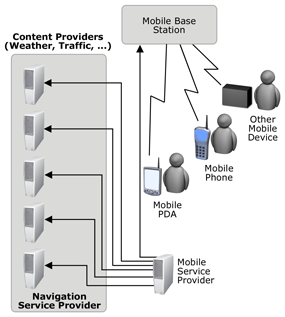MSP, NSPs and Other Content Providers
MSP, NSPs and Other Content Providers
In addition to the target mobile terminal, the relationship between navigation service provider and mobile service provider is an important factor. You will recall that a navigation service provider computes the response to a request for service by taking the location of the mobile terminal into account. The navigation service provider uses a computationally accessible model of the world to derive information about mobility in the real world. The mobile service provider has the direct customer relationship and hosts applications that depend on the capabilities of the navigation service provider and which also integrate information from a number of independent specialized content providers. From the mobile service provider's point of view, the navigation service provider is just one of many content providers. It is, of course, highly desirable for these content providers to use a common mechanism for delivering the content. The rise of XML as a data representation language and SOAP as a remoting protocol over the last few years has led to some convergence toward a common way to deliver content.
The .NET framework and its support by the MAGIC Services Protocol fit well with this trend. One of the surprising consequences is that both the providers and consumers of navigation services for location-based mobile services can maintain architectural relationships that mirror their business relationships.

Navigation Service Provider is one of many content suppliers
The MSP's customers, the end users, want to be able to carry a single device that can adapt to their surroundings as they move geographically and change modes of transportation. Applications built to rely on a standard navigation services platform such as MSP 2.0 will eventually allow geographic roaming and a choice of service providers the same way that is now possible with voice telephony. As is also happening in voice services, location-based services will eventually become transparently portable across geographic and carrier (or MSP) service boundaries.
Ultimately this locational transparency is essential to develop a mass market in location-based (and all non-voice) mobile services, if consumers are to perceive high value, ease of use, and lack of confusion in accessing the services.
Two other aspects of perceived value are also enhanced by developing interoperable delivery platforms. First, many improvements in the existing capabilities of a mobile device can be derived from personalizing and customizing the locality in which the device is used. Such customization is not an application in itself.
It is just a degree of location-awareness that can condition the operation of other services, such as voice and text messaging services, to the location of one or more users and the mobility characteristics of a geographic area.
For example, a network operator could provide a buddy-finder service for a group of people that have a business or social reason to meet. Some requirements to consider are individual location, time of day, urgency of the meeting, and other factors. Second, the cost of location-awareness is driven by data and development costs. Both can be reduced by ubiquitous location-aware mobile devices that can connect to service providers via network standard protocols and encodings and make industry standard navigation service requests via MSP 2.0.
| Previous Next |
EAN: 2147483647
Pages: 483
- The Second Wave ERP Market: An Australian Viewpoint
- Data Mining for Business Process Reengineering
- Healthcare Information: From Administrative to Practice Databases
- A Hybrid Clustering Technique to Improve Patient Data Quality
- Relevance and Micro-Relevance for the Professional as Determinants of IT-Diffusion and IT-Use in Healthcare
- Chapter III Two Models of Online Patronage: Why Do Consumers Shop on the Internet?
- Chapter IV How Consumers Think About Interactive Aspects of Web Advertising
- Chapter VIII Personalization Systems and Their Deployment as Web Site Interface Design Decisions
- Chapter XV Customer Trust in Online Commerce
- Chapter XVIII Web Systems Design, Litigation, and Online Consumer Behavior